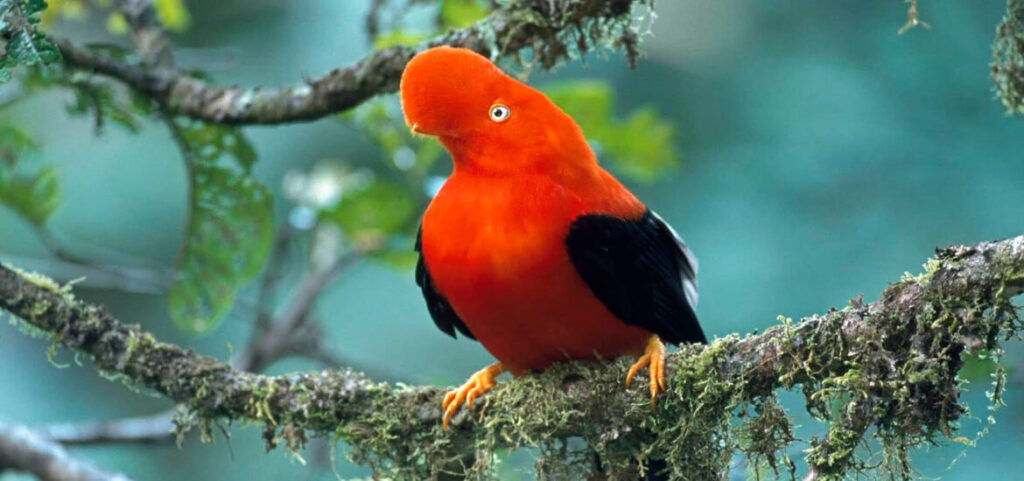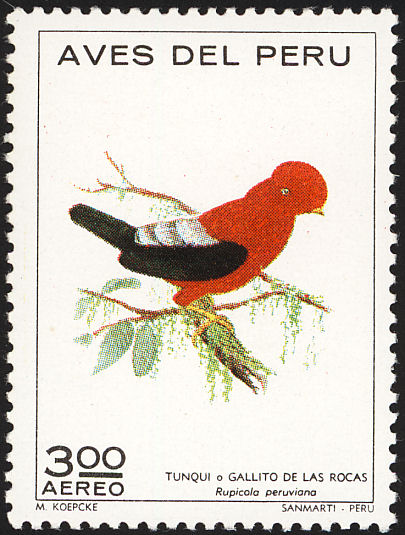This vibrant bird with striking red plumage is a symbol of Peru’s natural and cultural pride. The Andean Cock-of-the-Rock, or El Gallito de las Rocas in Spanish, is known as Tunqui in the Quechua language. It is one of the world’s most beautiful birds.
This small, captivating bird embodies Peru’s wildlife and culture and reminds us to protect the natural areas that are home to rich flora and fauna. Join us to explore this iconic species and its link to Peruvian identity, culture, and the Andes’ diverse ecosystems.
Characteristics

Its scientific name is “Rupicola Peruviana,” and its size is roughly the size of a medium chicken. It has sharp claws, small but strong legs, and a short beak. On females, they’ve got dark wings and a slightly brown color.

On the other side, the males are more beautiful. They’ve got stunning orange plumage, black wings, and their most characteristic treat, the comb above their head.
The reason why the female and male look totally different is because of what we call “sexual dimorphism. In a few words, this condition allows the male’s bright colors to catch the female’s eye, which makes reproduction easier. This bird loves eating insects, small vertebrates, and especially wild fruits and plays a vital role in nature by spreading seeds through the trees, keeping the ecosystem in balance.
Habitat and Distribution
The Andean cock-of-the-rock lives in the humid cloud forests of the Andes and Peruvian Amazon. This bird can also be found in other countries, such as Venezuela in the north to Bolivia in the south. It prefers altitudes from 500 to 2,400 meters in elevation, rich in plants and wildlife.
These birds are most commonly associated with steep ravines and rocky outcrops within the forest, giving them their name. Just like we mentioned before, dense vegetation provides essential cover and abundant fruit-bearing trees which is its main food source.
Key Habitat Features
Cloud Forests: These forests have high humidity, frequent mist, and lush plants. These conditions make the ideal place for gallitos for nesting and feeding.
Rocky Areas: As their name implies, these birds often build their nests on vertical rock faces, using mud and plant materials to secure them.

Biodiversity Hotspots: Their habitats often have a rich array of plants and animals. The cock-of-the-rock is an integral part of a complex ecosystem.
In Peru, the bird is common in national parks and reserves, like the Manu National Park, the Tambopata National Reserve, or even Machu Picchu. Visitors often say that on the Inca trail path or in the citadel itself have seen lots of specimens.
Courtship and Nesting
In mating time, males spend time in threes, trying to attract females’ attention. In some cases around 40 males can be seen around trees. Through movements and a dance that scientists call “lek” males do their best to find a couple. It’s interesting that the word “lek” has a Swedish origin, and it means dance place.
In the treetops, male birds leap and flutter while making special calls that catch the attention of nearby females. The females watch carefully, choosing the partner that suits them best for raising a family. Once they’ve made their choice, the female takes on the important task of building a cozy nest for her eggs.

After the female chooses her partner, she works hard to prepare everything and is the one who keeps the eggs warm and cares for the chicks. Once a female selects a mate, she takes sole responsibility for building the nest, incubating the eggs, and raising the chicks.
Although it may seem inconsiderate, the handsome male plays no part in parental care, leaving the female to ensure the survival of the next generation. Well, that’s how nature works.
Cultural and National Significance
The Gallito de las rocas holds deep cultural significance, particularly in Peru. Its vibrant appearance and unique behaviors have made it a symbol of the country’s rich biodiversity and natural beauty.

National Emblem
The bird was designated as Peru’s national bird in recognition of its striking beauty and its representation of the country’s diverse ecosystems. Its picture appears often in Peruvian art, tourism campaigns, and even in the 200 soles bill! All of this showcases its importance to national identity.

In Local Folklore
In stories from the Andes, there’s one legend that explains the origin of the gallito de las rocas. This tale portrays the gallito as a kind, brave bird who helps others. As a reward, his plumage turns a bright red-orange, making him different from the rest. This small legend also reflects themes of kindness, bravery, and the magic of nature in Peruvian folklore.
Importance in the Ecosystem
Besides the beauty that this tiny bird eludes, the cock-of-the-rock is vital for the Peruvian ecosystem. The key is its amazing digestive system: As a frugivore, after eating fruits it moves back and forth excreting feces mixed with the remains of fruits, which creates seed dispersion.

This process helps the environment to regenerate and makes it more diverse. The important role of seed dispersers is crucial, particularly in areas where other large frugivores are less abundant. It also contributes to the food chain as its diet includes insects, and is the prey of larger animals such as hawks, owls, or snakes.
Conservation and Threats
Although the importance of this bird is clear, currently is facing some challenges that threaten its future. A major issue is deforestation, mainly due to farming and illegal logging. These activities are damaging the bird’s natural home, which is essential for its breeding and feeding.
The Amazon rainforest for example, where this bird lives, is shrinking at a concerning pace. This loss disrupts the balance of the ecosystem and endangers many species, including the gallito de las rocas. Another concern is poaching, while it is not as widespread, it still poses a serious risk to this beautiful bird.

On a positive note, conservationists are working to protect the gallito de las rocas. One key area is the Manu National Park, considered a UNESCO World Heritage site. This place offers a safe space for many species, including gallitos. In this protected area, scientists and conservationists are working together.
This park also provides one of the few places where these birds can flourish without major threats. This effort is vital for maintaining biodiversity and the health of our planet. By safeguarding these ecosystems, we also protect the resources that local communities depend on.
Discover the beauty of the Cock of the Rocks
We encourage you to see our beautiful bird in action. Early in the morning, you can have more chances to see gallitos, as they take advantage of this time to mate. Keep in mind that the path of the Inca Trail or Machu Picchu are appropriate places to see it
The cock of the rocks is the symbol of our country and the vast Amazon rainforest. Whether you’re Peruvian or not, we must coexist with nature and learn to take care of it. If you’d like to see it in its natural habitat, Viagens Machu Picchu can help you out.
We operate in Peru and its different destinations, including the Amazon. Contact us to take the first step to know Peru and its vast and incredible species. We’re waiting for you!
Viagens Machu Picchu, journeys that inspire, moments that last.

